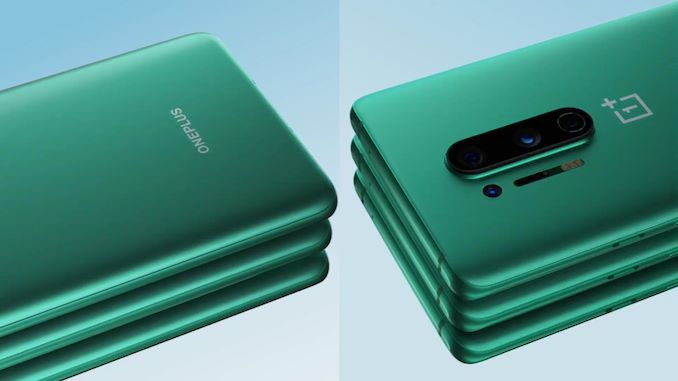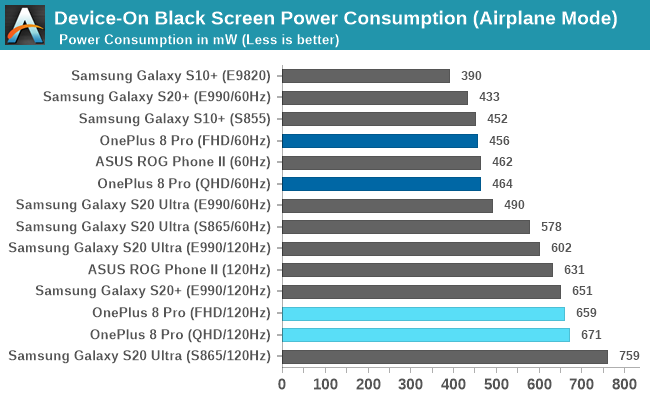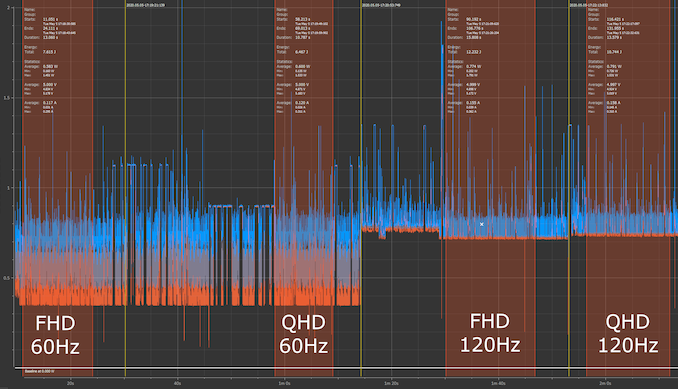120Hz On The OnePlus 8 Pro: QHD+ Resolution But Still Power Hungry
by Andrei Frumusanu on May 5, 2020 1:00 PM EST- Posted in
- Mobile
- Smartphones
- OnePlus
- OnePlus 8 Pro

High refresh rate displays in smartphones are all the rage in 2020, but the new exciting feature is still in its infancy in terms of hardware implementations. Currently there’s still a lot of caveats when using the higher refresh rate, particularly a large impact on the battery life of the phone.
A few weeks ago we covered the characteristic in Samsung’s Galaxy S20 series, noting how it results in a quite large bump in the power consumption of the device, even when seemingly not actually displaying any dynamic content on-screen.
The new OnePlus 8 Pro is another 120Hz flagship device that’s been recently released, and we finally managed to get our hands on a sample. Curiosity got the best of me and the power consumption of the phone at different refresh rates was amongst the first things I tested, particularly because the phone offers the 120Hz refresh rate at a native QHD+ software rendering resolution – something Samsung’s Galaxy S20 series can’t do.
Observing the input power of the phone for a more graphical representation of the different modes, we immediately see that OnePlus’ 120Hz mode incurs a similar power jump to that of the Galaxy S20. The figures here aren’t quite correct as the phone’s power usage when connected to USB is unusually high so don’t pay too much attention to those numbers – just at the differences between the modes.
We can also see that there’s extremely little difference in the base power consumption of the phone between the FHD and QHD modes, both at 60Hz and 120Hz refresh rates. This is actually an important indicator as to narrow down whether the power draw comes from the SoC, or the display panel or DDICs.

Re-measuring the power in a more correct manner, the OnePlus 8 Pro falls in line with other phones of this generation, both at 60 and 120Hz.
We had expected the OnePlus 8 Pro to fare off worse than the Galaxy S20 series, and yes it does draw slightly more power – but not as much as I had initially thought it would. The hardware differences between the phones here relates to their display interfaces, the Galaxy S20 series features a single MIPI lane to the DDIC, a bottleneck that is the reason for why the phone can’t do QHD at 120Hz. The OnePlus 8 Pro on the other hand does feature dual MIPI interfaces to the display panel and thus has the bandwidth necessary for driving the higher refresh rate at the highest resolution.
The fact that the differences between the two phones is only a mere 20-25mW means that the display interfaces have very little to do with the increased power draw. The difference in the base power consumption between FHD and QHD modes is a mere 10mW, so seemingly that also has very little impact on power other than the additional power to actually render higher resolution dynamic content.
It seems that the power consumption here solely is to blame on the DDIC and the display panel itself, both having to work harder to drive the pixel matrix at higher frequencies. It’s a somewhat discouraging confirmation as it means the ecosystem is in dire need for true VRR (variable refresh rate), where the panel doesn’t need to be driven like this during static content.
We’ll be reviewing the OnePlus 8 Pro in more details in a full review in the coming weeks – today’s quick pipeline was just meant to address this burning matter of the 120Hz implementation of the phone. Generally, I expect the 120Hz mode here to have a slightly higher battery impact than what we saw on the S20 series, but nothing to drastically worse.











27 Comments
View All Comments
Kishoreshack - Tuesday, May 5, 2020 - link
The only thing I understand from this Is quad hd+ plus 120 hz can't be enabled on S20 Ultra via a software updateThe hardware bandwidth is limiting here
Kishoreshack - Tuesday, May 5, 2020 - link
Need a guide on how True VRR worksWouldn't it consume battery to continuously detect static or dynamic content on the screen ?
Alim345 - Wednesday, May 6, 2020 - link
Nope, it should not consume more energy.VRR is basically about showing new frames whenever they are ready without waiting for next refresh slot.
drexnx - Tuesday, May 5, 2020 - link
do any of these devices have Panel Self Refresh? has that become a standard these days or was it just a one-off on the LG G2?MrCommunistGen - Wednesday, May 6, 2020 - link
I feel like several devices over the years have had panel self refresh, but a quick internet search didn't come up with meaningful results. This is a spec that isn't really advertised/exposed much, even in moderately in-depth reviews.eastcoast_pete - Tuesday, May 5, 2020 - link
Would be nice to be able to assign a default refresh rate to different apps on a phone like this. So, 120 Hz for games and similar, 60 Hz for email etc. That'd keep power draw somewhat under control, until devices withtrue VRR are out.
ksec - Wednesday, May 6, 2020 - link
Waiting to see if Apple has Pro Motion this year